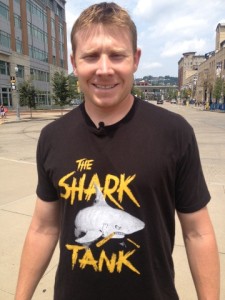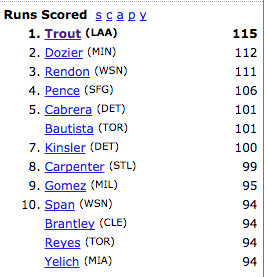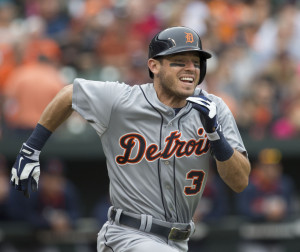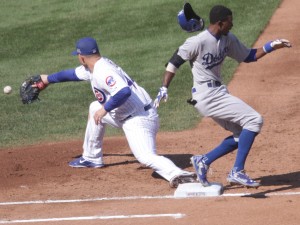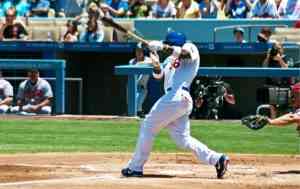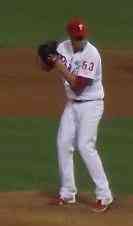 I play in a mixed fantasy baseball league with 14 friends. We meet in Arizona at the First Pitch conference in November and auction off 23-man teams for $260. It’s a keeper league, you can keep up to 15 players each year, and in the auction you’re limited to players who finished the previous season on a major league team’s active roster. When you roster someone without major league experience their price escalated by $3 each season after they make the majors. Other players’ prices go up by $5 each year they’re kept.
I play in a mixed fantasy baseball league with 14 friends. We meet in Arizona at the First Pitch conference in November and auction off 23-man teams for $260. It’s a keeper league, you can keep up to 15 players each year, and in the auction you’re limited to players who finished the previous season on a major league team’s active roster. When you roster someone without major league experience their price escalated by $3 each season after they make the majors. Other players’ prices go up by $5 each year they’re kept.
We started playing in 2003, and made up a set of fantasy rules that are unlike any other league in the world, with the goal of having a simple-to-administer keeper league. It has worked out pretty spectacularly. I love going to Arizona to see AFL baseball and my friends, but making sure I’m at the auction is very important. You can’t play if you don’t auction.
The second part of roster provisioning is a 17-round reserve draft in late March, during which you can draft anyone in the world who hasn’t already been rostered. We’ve had high school players drafted, and players years away from Japanese free agency. The teams draft in order of last year’s standings. At the end of the day,  in time for Opening Day, each team has 40 players for the season.
Since this is a keeper league, dump trades are a part of the process, but each year it seems that teams with bad teams dump earlier than they did previously. Last year there were seven dump trades on May 19th, just seven weeks into the season.
We’ve recently been discussing whether these early dumps are a good thing or not for our game. I thought not, because it felt as if marginal teams were in a race to the bottom. The first ones to bail were able to pick off the best prospects from the teams competing for the top, so there was constant pressure to bail earlier, in order to make the best deal.
This meant that other teams were pressured to make deals as early as possible, too, in order to compete. Once teams dumped, they were no longer competitive, and once teams added real talent they were no longer catchable.
My suggested solutions, a variety of them, all involved increasing the pain for teams dumping. For instance, teams that fell below a certain number of points would lose some of their freezes, depending on how far short they fell. Or the price of players traded before the All Star break might be automatically increased to $10 or more, in order to decrease their value as keeps. Or they would pay a financial penalty, depending on how many points they fell below a threshold. This isn’t a money league and there is no reason to reward winners, but the money could go to charity, simply to induce a little pain if standards weren’t achieved.
Other suggestions, like a reduced inseason salary cap and having losers pay winners some amount, were suggested by others. These are all standard ways for leagues to control dump trades, but in this league at this time these suggestions were met mostly with derision, primarily with the not-really-an argument notion that in a keeper league you can’t/shouldn’t punish dumping. Though that isn’t what any of us were suggesting.
I started this post spoiling for a fight about this and thought that maybe a look at the trades made last May 19th would help me win my argument (something I know never happens on the Internet, or anywhere, really). On May 19th…
The team that eventually finished first traded Garin Cecchini, Dom Smith, and Wily Peralta in two trades for Joe Nathan, Adam Jones and Prince Fielder (when he was still expected to come back). (14 and 13)
The team that eventually finished second traded Matt Harvey and Alexander Reyes for Ben Revere and Adam Wainwright. (15)
One of the teams that tied for third traded Maikel Franco, Marcus Stroman and Daisuke Matsuzaka for Pedro Sandoval, Alcides Escobar and Francisco Rodriguez. (11)
My team was the other team tied for third and didn’t make a trade.
The team that finished fifth didn’t trade.
The team that finished sixth traded Miguel Sano and Matt Moore for Mark Teixeira and Kenley Jansen. (15)
The teams that finished seventh and eighth didn’t trade.
The team that finished ninth traded Alex Meyer and Addison Russell for Ian Kinsler and Asdrubal Cabrera. (14)
The team that finished 10th traded Gregory Polanco and Miguel Gonzalez for Troy Tulowitzki and Brett Gardner. (13 and 12)
All the teams that traded away quality players finished in the bottom five in the league. The teams that finished first and second traded away quality prospects for immediate help and were never caught.
This division, last year, clearly meant that there were teams that were winning, teams that were losing, and then a bunch of teams in the middle who could not win and would not lose.
That in itself isn’t a problem. It’s part of the game dynamic. There is no penalty in our rules for coming in last. In fact, Brian Walton came in last this year with a pathetic number of points (28.5), and that’s a good thing! As he explains, if you’re going to dump you should go all in, trade in this year’s assets to improve next year’s squad.
But that brings us back to dumping in May. There is a problem if somewhat competitive teams are willing to sacrifice their season so early, basically locking in the tiers of competition. The problem is that this is less fun for many teams, and devalues the auction that we enjoy so much. My suggestions of adding friction to dumping wouldn’t end dumping, but they might slow the process, and make the stakes higher for the dumping teams. They would have to not only reload their squads, but try to claw for points this year (and would be rewarded for their success).
This would be good, because it was make it easier for the teams that didn’t trade away prospects early to remain competitive longer. For instance, my team didn’t trade prospects in mid May because it got off to a horrible start (bad pitching mostly) and was in 11th place on May 19th. The team looked too good to dump, but was not competitive enough to buy by trading away prospects. Of course, once we didn’t buy we had no chance to catch the teams that did when we started rising in the standings.
If the trading didn’t get going until June we might have been tempted to trade Oscar Taveras and Archie Bradley. Instead, we decided to play for third, which is a different way of playing for next year.
While trying to make my argument, I looked at the May 19th standings and wasn’t exactly surprised to see that the bottom four teams finished in the bottom five at the end of the year. After all, they had traded excellent players for futures, most of whom didn’t contribute much this year at all.
What surprised me more was that a look at the Draft Day Rosters, the team that was bought in November (something of a less than perfect estimate of the amount of talent a team had last year on Opening Day), three of the five lowest finishers were in the bottom four (the other two were sixth and ninth). If anything, with the die cast before the season started, it seems as if these teams actually waited too long to dump. Or maybe, it was the teams that were contending who waited to be sure they were in the fight before swapping their top prospects and futures for reinforcements.
In either case, the problem I thought I was actually seeing was subtly different than the one I had diagnosed.
Instead of marginally talented teams racing to dump, mostly truly bad teams recognized they were better off dumping than not. Increasing friction for them might make the game marginally more interesting inseason, and might protect the value of the auction a bit, but any rational player with a bad team would still dump.
I suppose this seems like a fairly esoteric tale. A league unlike any other trying to fine tune rules that aren’t working all that badly isn’t much of a tale. But what I found in the telling was evidence that the problem I was seeing wasn’t totally the problem I was experiencing.
I still think adding some friction for teams that finish poorly is a good idea, simply to make sure they take it seriously. Just because they usually do doesn’t mean an incentive doesn’t help order things properly. After all, two of those bottom five teams  had Top 10 teams based on the Draft Day Standings. Why were they dumping a quarter of the way into the season? Because that’s when you can get the best prospects.
This friction, call it an incentive, isn’t a punishment. That definition is what got me riled in the first place. Every league’s rules define limitations that shape the way the game is played. Deadlines, keeper rules, categories, position eligibility all shape the way the game is played. In the context of the current rules, adding more restrictions might seem like punishing certain behavior when it’s really incentivizing others.
But to go back to Brian Walton, he hits the nail on the head in his story when he says, “It is always best to agree on the original problem statement before throwing around ways to address it.”
Our division is between those who think we can make the game better (but have to recognize that the problem at this point isn’t acute) and those who think dumping and rebuilding should be an unfettered process (apart from the inseason salary cap, of course), who don’t see a problem.
So, for now, we take no action, but we each snap our lips trying to make the other side see reason. It’s almost Hot Stove season.


